 Antiphonary, 15th c. Antiphonary, 15th c.
Antiphonaries, i.e. liturgical books containing texts and notation of chants for the mass, had to be made on large formats in order to make them visible from a distance by the entire choir. Due to their role, they usually also included attractive artworks. The antiphonary preserved in the collections of the museum originates from the Southern Italy or Spain and was made in the 15th century. It contains three full-page miniatures presenting King David playing the harp, Jesus banishing the merchants from the temple and Jesus arriving at Jerusalem. The author is Giovanni Battista da Rossa, painter active in the second half of the 15th century in the Southern Europe. The antiphonary made of parchment is bound with boards and leather and equipped with metal shoes and a large ex libris. It weighs 18 kg. |
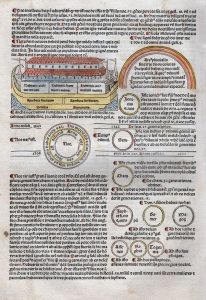 Jacobus de Voragine, Legenda aurea sanctorum, sive Lombardica historia, Nuremberge 1481 Jacobus de Voragine, Legenda aurea sanctorum, sive Lombardica historia, Nuremberge 1481
Legenda aurea (Golden Legend) is the largest and most popular Medieval collection of the legendary lives of the saints. Information is collected by the author based on verbal transmissions and early compilations. He arranged the legends in accordance with the church liturgical calendar. The popularity of this work is evidenced by the fact that until today, approx. 800 copies have been preserved. Already in the 16th century, the Golden Legend was translated into Polish version, which is currently preserved only partially.
|
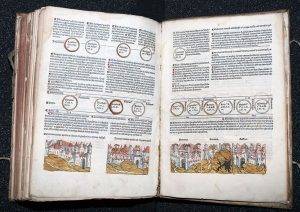 Werner Rolevinck, Fasciculus temporum, Venice 1485 Werner Rolevinck, Fasciculus temporum, Venice 1485
The work of Werner Rolevinck is a typical medieval history of the world. Pages were split into “sections”. The centreline represents the tradition of Christianity. The main figures of the biblical history, presented in colourful circles, form a linear genealogical chart. Above the centreline, there is a section devoted to secular events. It contains descriptions related to the history of Assyria, Babylon or Rome. The birth of Christ, as a breakthrough in history, was clearly identified with a graphic character. It is followed by the history of Church, popes and modern world with its Roman and Byzantine Emperors and Kings of France and Germany. The chronicle ends with 1284. The value of Fasciculus temporum as a historical source is minor. However, the work is an important historical example of medieval printing with extensive range of pictures. |
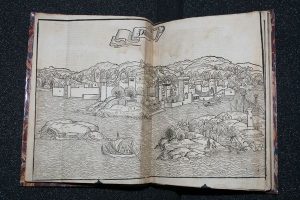 Bernard de Breidenbach, Peregrinatio in Terram Sanctam, Mainz 1486 Bernard de Breidenbach, Peregrinatio in Terram Sanctam, Mainz 1486
The work of Bernard Breidenbach, German cleric and doctor of law, is an account of his trip to Palestine. The author travelled from Venice to Jerusalem through Venetian islands. The work contains wood engravings and texts describing the locations he visited. Next to the descriptions of the holy Christian places, B. Breidenbach included descriptions of ethnic and confession groups living in the Holy Land, Jews, Greeks, Syrians, Franks, Saracens, Jacobites, Nestorians and Maronites. Information about the people and confessions was enriched with illustrations and predicted alphabets used by them. The second part of the work is a description of travelling to St. Catherina’s Monastery on Sinai by the author and Jan de Solms and Philip de Bicken. Apart from Sinai, B. Breidenbach also describes Egypt and its areas. The whole material is supplemented with the list of islands owned by Venetia. The work, published in print by Peter Schöffer in 1486 is one of the first printed itineraries. Its Schwabacher typeface was added to typography one year earlier. Decorative woodcuts were made by Erhard Reuwich. |
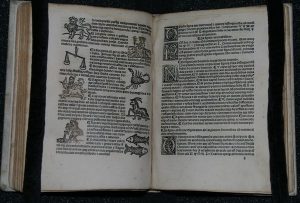 Albumazar Abalahi, Introductiorium in astronomiam, Erhard Ratdolt, Augsburg 1498 Albumazar Abalahi, Introductiorium in astronomiam, Erhard Ratdolt, Augsburg 1498
Kitab al-mundhal al-Kabir or Introductiorium in astronomiam (Introduction to astronomy) contains five books discussing separate notions. Book I deals with the origin and history of astronomy, book II discusses the movements of celestial bodies, book III describes in detail astronomical phenomena, book IV is devoted to proving astronomical statements. The last book V discusses the benefits of astronomy. The Introduction to astronomy text was translated by Hermann Dalmata. Erhard Ratdolt (1447-1527) who published this work in print ran a printing house in Venice in 1476-1485 and after 1485 in his family town of Augsburg. He was famous for his woodcut initials with white plant ornaments on black background, called “litterae florentes”, which were used to decorate Albumazar’s work as well.
|
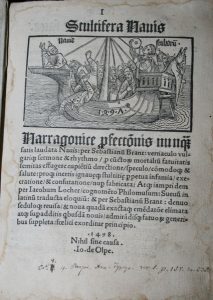 Sebastian Brandt, Stultifera Navis, Basel 1498 Sebastian Brandt, Stultifera Navis, Basel 1498
Das Narrenschiff or Stultifera Navis (The Ship of Fools) is a collection of short, two-page moralistic poems written in rhythmical blank verse. The author ridicules human vices and imperfections, e.g. greed or waste studies. Each poem contains its own woodcut. Next to the illustrations, there are references to the Bible. The work is supplemented with many prefaces and epigrams by Thomas Beccedelli and others. The value of Das Narrenschiff, preserved until today in many copies, is based not only on its unique character but on the high craftsmanshift in illustrations made Albrecht Dürer himself. |
 Jacques Lefevre d’Etaples, Quincuplum Psalterium, Paris 1500 Jacques Lefevre d’Etaples, Quincuplum Psalterium, Paris 1500
In all old prints preserved in the collections of the Museum, definitely the most valuable work is Quincuplum Psalterium. In the first part of his work, the author compiled three versions of translated Psalms by St. Jerome and supplemented them with his own explanations and comments. In the second part he included selected psalms from “Vetus Latina”, i.e. Latin translation of the Bible dating back to the period before St. Jerome activities. It contains translation of psalms, which J. Lefevre considered to be the most accurate. This research item brought the author great fame, however, since this work was not available for wider circle of readers, today it is rare. The Museum copy of “Quincuplum Psalterium” by Jacques Lefevre d’Etaples is the only copy preserved in Poland and one of the few in the world. |
 Jan Długosz, Vita Sancti Stanislai, Cracoviensis Episcopi, Cracow 1511 Jan Długosz, Vita Sancti Stanislai, Cracoviensis Episcopi, Cracow 1511
The Life of St. Stanisław, Cracow Bishop is an extensive work containing three parts, referred to as “hektets”, dedicated to the Sędziwój of Czechło and ending with a summary and description of miracles by St. Stanisław. Next, the work contains legends of saints from or connected with Poland and neighbour countries, St. Wojciech, St. Florian, St. Stefan the King, St. Jadwiga, etc., probably not written by Jan Długosz. The work was very carefully bound in the Royal Press of Jan Haller and is one of the earliest Polish prints. |
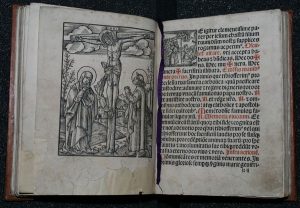 Missale Cracoviense pro itinerantibus, Cracow 1525 Missale Cracoviense pro itinerantibus, Cracow 1525
Cracow Missal is one of the earliest prints of Poland. It was made on the press of Jan Haller in Cracow, in the first Polish printing house. The Museum holds an exclusive edition of the Missal, issued as “in quarto” format and used by clericals who travel, for whom missals with standard sizes would be uncomfortable. It is carefully printed with a few types of fonts and alternating black and red colours, which adds elegance and attractive look. The Cracow Missal consists of two parts. The first part, preceded by an index, includes the mass order per Sundays in church year, starting with the Advent. The second part, much shorter, includes the mass order per intentions, e.g. for sins, decent death, pope, church, etc. |
 Sebastian Münster, Cosmographie oder Beschreibung aller Ländern, [Basel 1550] Sebastian Münster, Cosmographie oder Beschreibung aller Ländern, [Basel 1550]
Cosmograhpia by Sebastian Münster is one of the popular descriptions of the works in the 16th century. While writing, the author referred both to ancient books and contemporary authors. The work by S. Münster shows the ambition to be a “summary” of the knowledge on the world so it contains information across all science fields. Descriptions of individual countries are started with geographical details, then history, rulers, etc. The text is complemented with many maps, genealogy charts and illustrations. |









